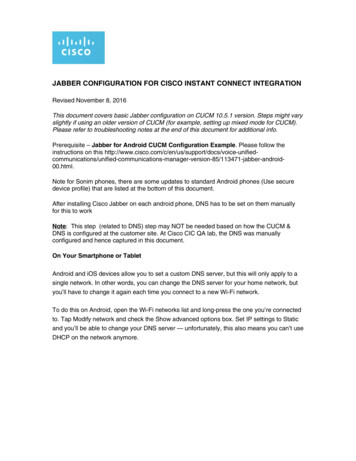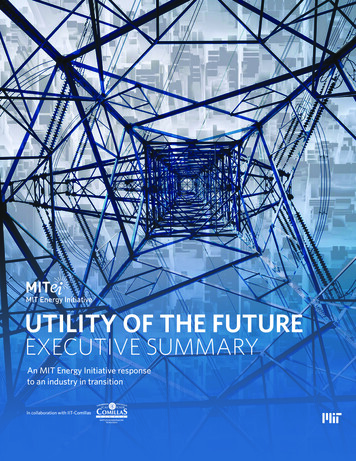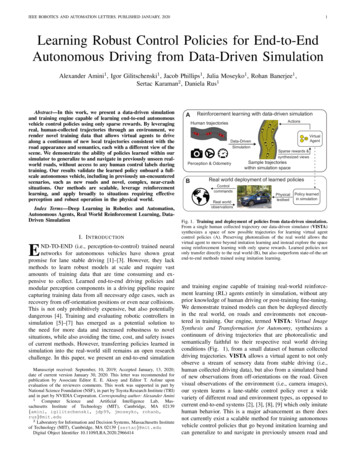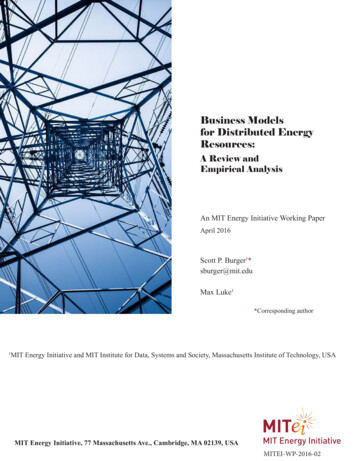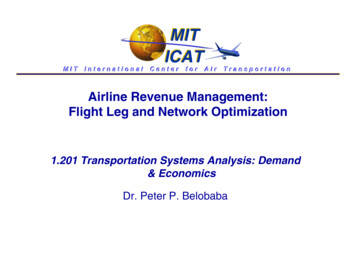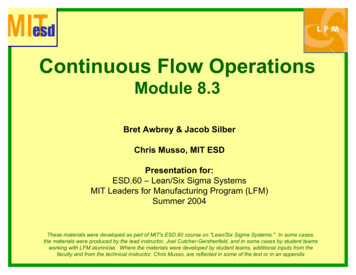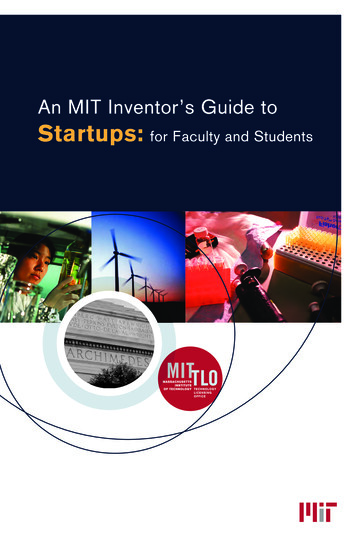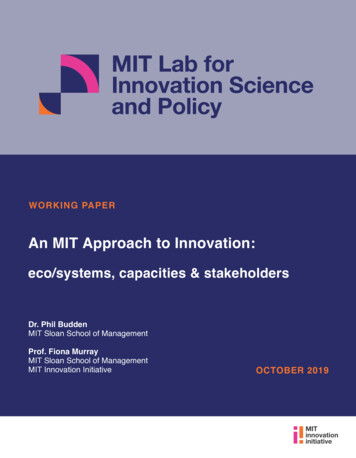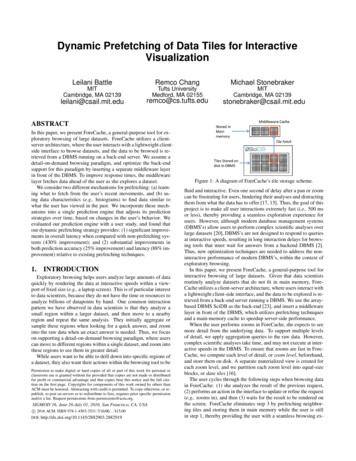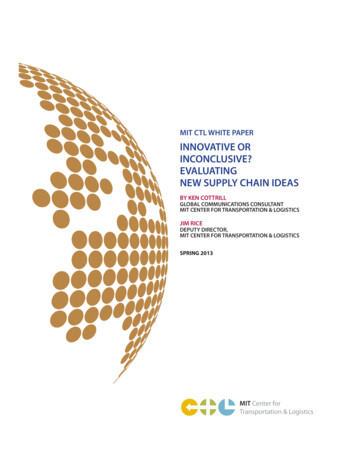
Transcription
MIT CTL WHITE PAPERINNOVATIVE ORINCONCLUSIVE?EVALUATINGNEW SUPPLY CHAIN IDEASBY KEN COTTRILLGLOBAL COMMUNICATIONS CONSULTANTMIT CENTER FOR TRANSPORTATION & LOGISTICSJIM RICEDEPUTY DIRECTOR,MIT CENTER FOR TRANSPORTATION & LOGISTICSSPRING 2013MIT Center forTransportation & LogisticsXD1758 MIT-CTL Ideas.indd 15/21/13 9:03 AM
CONTENTSExecutive Summary.3Introduction.4What Is SCI?. .5Cloud Computing. .7Omni-Channel Retailing.123D Printing.17Buyer Beware.22MIT Center forTransportation & LogisticsXD1758 MIT-CTL Ideas.indd 2INNOVATIVE OR INCONCLUSIVE? EVALUATING NEW SUPPLY CHAIN IDEAS 25/21/13 9:03 AM
2Executive SummaryEven though supply chain innovation (SCI) is a key component ofcorporate competitiveness, there is no commonly accepted definition of the concept. It is important to address this issue. The pace atwhich new ideas are introduced has increased markedly over recentdecades, and companies cannot afford to be behind the curve because they are unable to effectively evaluate the latest innovations.The MIT Center for Transportation & Logistics (MIT CTL) has launcheda research project to better understand SCI, and to help companiesassess the potential of new ideas in terms of their supply chains. Theproject has developed a working definition of SCI, and is creating aframework for evaluating these concepts.In this white paper MIT CTL gives a brief description of the initialresearch findings, and undertakes a basic assessment of three verydifferent innovations that have the potential to reshape supply chains:cloud computing, omni-channel retailing, and 3D printing. Each oneis reviewed according to the positive changes in cost, cash, and/orservice that result from its introduction, as encapsulated in the working definition of SCI.Cloud computing is the most advanced in that many supply chainapplications are now in use, and the technology is delivering positive results. Omni-channel is not an SCI per se, but its implementationrequires a number of supply chain innovations. Developments in 3Dprinting could revolutionize manufacturing and hence supportingsupply chains, but these advances have yet to emerge. In the lattertwo cases the positive deliverables are still unclear.The assessment underlines the need for companies to carefully evaluate SCIs, and to avoid being caught up in the hype that often surrounds exciting ideas. Another important lesson is that many SCIs arenot original concepts, but reconfigurations of existing innovations.MIT Center forTransportation & LogisticsXD1758 MIT-CTL Ideas.indd 3INNOVATIVE OR INCONCLUSIVE? EVALUATING NEW SUPPLY CHAIN IDEAS 35/21/13 9:03 AM
IntroductionSupply chain innovation (SCI) is a key source of competitive advantagefor many companies. Some enterprises such as Wal-Mart and Zarahave gained dominant market positions as a direct result of their innovative supply chain models.Yet SCI is not well understood. There is no clear, commonly accepteddefinition of the concept; one company’s SCI is another company’sprocess improvement.Does this lack of clarity matter? We argue that it does – particularly intoday’s fast-changing business environment.Misjudging a new idea because of uncertainty over its applicabilitycan result in a missed opportunity or wasting resources on a conceptthat is still years away from fruition. Witness the flawed vision of radiofrequency identification (RFID) technology that persuaded many companies to heavily invest in systems prematurely.MIT CTL has launched a research project to better understand SCI, andto develop a framework that could help companies pursue innovationin their own supply chains.In this white paper we use some of the preliminary observations of theresearch, along with interviews of supply chain professionals, to carryout a very basic review of three recent developments that could transform supply chains: cloud computing, omni-channel retailing, and 3Dprinting.MIT Center forTransportation & LogisticsXD1758 MIT-CTL Ideas.indd 4INNOVATIVE OR INCONCLUSIVE? EVALUATING NEW SUPPLY CHAIN IDEAS 45/21/13 9:03 AM
4What is SCI?Our initial research on SCI shows that in most cases it is confused with– or at least informed by – the idea of product innovation. Yet thereare important differences between the two.While it may be easy to copy a product, for example, the same cannot be said for a process; each application of a process requires somecustomization and adaption. Also, not all SCIs are equally applicable inall industries. An example is Dell’s make-to-order and sell-direct models, which were thought to be worthy of copying when they gainednotoriety in the computer industry. But these supply chain models aredifficult to apply in, say, a continuous process industry such as steelmaking. To some extent the advent of the mini mill moves steelmaking in the make-to-order direction, but this has required a great dealof customization to make the approach possible.Other challenges exist for those attempting to understand SCI. Acommon misconception is that a true innovation has to be new. Yetmany (in fact most, according to the early observations of the MIT CTLresearch) highly successful innovations in the supply chain field areestablished ideas that have been redeployed in creative ways.The nature of SCI raises a number of questions. For instance: Is SCI the new method being used, or the application of thatmethod? Is the innovation the base technology, or when that basetechnology moves beyond its invention and is actually applied to produce measurable results?We argue that an invention creates something from scratch, whereasan innovation creates something new by combining and applying aMIT Center forTransportation & LogisticsXD1758 MIT-CTL Ideas.indd 5INNOVATIVE OR INCONCLUSIVE? EVALUATING NEW SUPPLY CHAIN IDEAS 55/21/13 9:03 AM
mix of inventions, existing processes, and/or technologies to achieve adesirable change in performance and capability.Earlier we referred to RFID, an important development in the supplychain world but one that also amply illustrates the pitfalls of misdiagnosing what an SCI means in practice.The base technology that makes RFID possible was developed in the1940s. The first transponder was introduced in 1973, and the first RFIDpatent was registered in 1983. But these developments were notturned into track and trace applications until the 2000s.When first introduced as a supply chain application the technologycaused much excitement, and some companies rushed to adopt it. Butthey failed to fully appreciate the conditions necessary for successfulapplications of RFID, and underestimated the technology’s constraintsand limitations. Many organizations discovered that although RFIDcould improve the efficiency of supply chains and might offer newcapabilities, the number of suitable applications was far less thanoriginally envisaged. It would take a number of years before actualimplementations achieved productive change.Examples like this should not detract from the importance of SCI, however. Innovating in the supply chain domain has become an importantsource of improvement for organizations. One research study maintains that competing in process and supply chain is more sustainablethan in products. 1 This is because the resources allocated in SCMgenerate more cost savings and have a greater long-term impact thannew product introductions, which tend to be more hit and miss.This viewpoint is consistent with the description of supply chaininnovation provided by Bello et al. (2004), who assert that “supplychain innovations combine developments in information and relatedtechnologies with new logistic and marketing procedures to improveoperational efficiency and enhance service effectiveness.”MIT Center forTransportation & LogisticsXD1758 MIT-CTL Ideas.indd 6INNOVATIVE OR INCONCLUSIVE? EVALUATING NEW SUPPLY CHAIN IDEAS 65/21/13 9:03 AM
6To help provide some clarity about the definition, we offer the following based on early observations from our research: Supply chaininnovation is the combining and application of a mix of inventions, existing processes, and technologies in a new way that achieves a desirablechange in cost, quality, cash and/or service.It is useful to note that the supply chain innovation may be new to acompany but not new to the industry; or it could be new to an industry in total. This leads us to suggest that there are two classes of SCI:local and global.Local SCI occurs at the company or business-to-business level, wherethe concept is new to the enterprise. A novel cross dock operationmay be new to a company, but is not revolutionary in an industrysense, for example. Still, the company does have to adjust and modifyinternal practices and processes, which is part of the innovation process.Global SCIs occur more often at the industry level where the innovation is new to all competitors. The research data indicates that manyindustry-level SCIs have been developed by third parties, and theseinnovations create an opportunity for change for all competitors. Theytypically take a long time to mature, but on reaching maturity usuallygenerate large-scale change. Examples include containerization bySeaLand and the introduction of overnight shipping by FedEx.Let’s look at three global-level developments in the context of ourworking definition of SCI.Cloud computing (aka Software-as-a-Service or SaaS)The National Institute of Standards and Technology defines cloudcomputing as, “a model for enabling convenient, on-demand networkaccess to a shared pool of configurable computing resources (e.g., networks, servers, storage, applications, and services), that can be rapidlyMIT Center forTransportation & LogisticsXD1758 MIT-CTL Ideas.indd 7INNOVATIVE OR INCONCLUSIVE? EVALUATING NEW SUPPLY CHAIN IDEAS 75/21/13 9:03 AM
provisioned and released with minimal management effort or serviceprovider interaction.” 2The technology can be deployed as a private, community, public, orhybrid cloud. And the most familiar service model is software-as-aservice, where consumers use the provider’s applications that run on acloud infrastructure.Time lineCloud computing has become widely adopted by companies in various disciplines including supply chain management. According to theresearch firm Gartner, Inc., the public cloud services market is forecastto grow 18.5 percent in 2013 to total 131 billion worldwide, up from 111 billion in 2012.The concept is by no means new, however. According to some accounts, the term was first coined back in the mid-nineties.3 And someof the base aspects of cloud technology have been in place a longtime. Companies were using centralized computing and storagesystems decades ago, for instance. What has changed since then is therelative ease of access and low cost, which make the technology morereadily available for broader adoption.Even within the supply chain domain the idea of a web-based community has been around for some time. A senior supply chain manager in a specialty chemical manufacturer described the introductionof such a system in the bulk tanker business 10 years ago. The systemwas designed to eliminate the middle-man by enabling companies tocommunicate with each other virtually. Users exchanged data throughthis early version of a cloud, and were able to automate documentation such as demurrage statements.The system was not a success, “but it was a precursor to what we havenow (cloud computing),” says the supply chain manager.MIT Center forTransportation & LogisticsXD1758 MIT-CTL Ideas.indd 8INNOVATIVE OR INCONCLUSIVE? EVALUATING NEW SUPPLY CHAIN IDEAS 85/21/13 9:03 AM
8Positive ChangesHaving evolved to a stage where companies are actively using cloudbased applications, the technology is delivering positive change. Hereare some examples.Supply chain communications and visibility. The capacity of the cloud tocreate virtual communities of users is one of its most powerful attributes. Participant companies are linked with each other and exchangehuge volumes of data, providing near real-time communications. Thedata is also being used to develop more timely and precise shipmenttracking and tracing capabilities.Before it adopted a cloud-based logistics management system a toymanufacturer had limited visibility into its inbound transportationoperations. The company relied on its carriers to provide updates. Thenetwork is now being expanded to the organization’s entire globalfreight network. In another example, a chemical company uses itscloud application to negotiate freight rates with more than 28 oceancarriers.Analytics. The flood of data emanating from cloud-based systemsis being used to develop more advanced supply chain analytics.The practitioners we interviewed pointed to a number of examples,including the creation of more detailed carrier scorecards and thepredictive modeling of fuel prices and cargo densities across freightnetworks.Dynamic routing. Data stored in the cloud is being used to dynamicallyroute shipments. A third-party logistics provider has reduced the number of driver days in its distribution network by using dispatch datafrom the cloud to re-route drivers in response to changing customerdemand, for instance. The advisories can be very detailed; drivers caneven be directed where to take right and left turns to minimize transittimes.MIT Center forTransportation & LogisticsXD1758 MIT-CTL Ideas.indd 9INNOVATIVE OR INCONCLUSIVE? EVALUATING NEW SUPPLY CHAIN IDEAS 95/21/13 9:03 AM
Risk management. With the benefit of increased supply chain visibilityand more sophisticated analytics, companies can be more effective inmitigating supply chain risk. The “100% shipment visibility” affordedby its cloud-based application can improve the management ofdisruptions such as port strikes, says a leading food products manufacturer. The technology gives decision-makers the information onresource availability and location they need for optimal deployment.Cloud-based applications could achieve even more as the technologymatures. Harnessing the cloud’s unparalleled capacity for buildinguser communities to develop cross-industry collaboration is one application area that offers vast potential.“By making transportation more efficient you make the world smaller,”says a senior supply chain manager in the chemicals business. Hepoints to ocean shipping as a mode where the sharing of operationaldata could achieve paradigm-shifting efficiencies. In the past, companies have resisted the pooling of commercially sensitive information,he says. But cloud-based groups of shippers and carriers, adjudicatedby a neutral party, can overcome these barriers (MIT CTL is engagedon a project to improve the efficiency of ocean shipping by analyzingoperational data from stakeholders across the industry.)4Another area rich in possibilities is using the cloud to extend theconcept of a supply chain control tower. Some leading companies areusing control tower systems based on a software-as-a-service modelto manage freight networks across countries. It is possible to cut logistics costs by using these systems to create international scorecardsand benchmarking initiatives. In the future, these systems may enableshippers and carriers to drill down much further into the performanceof multi-country freight networks.MIT Center forTransportation & LogisticsXD1758 MIT-CTL Ideas.indd 10INNOVATIVE OR INCONCLUSIVE? EVALUATING NEW SUPPLY CHAIN IDEAS 105/21/13 9:03 AM
10Negatives/ChallengesThe sheer volume of data generated by cloud-based supply chainmanagement systems can be a drawback.“We get a phenomenal amount data on transit times, fuel spend, awhole range of metrics, and it can be overwhelming,” says a supplychain manager in a food major products company.The problem recently persuaded the company to drop the third-partyprovider of cloud technology it was using. Receiving huge amounts ofoperational data was not enough, “we want a provider that not onlysupplies the data, but is also intelligent about the data,” says the supply chain manager. An example is pinpointing exceptions and helpingthe company to identify areas where it can raise efficiency levels. Theorganization intends to contract with a global freight forwarder tosupply this type of service.Another challenge is providing the global coverage that is fundamental to cloud-enabled control tower systems. This can be difficult whenpartners across the globe are at different stages of development.“A carrier may trade under one name but their offices across the worldmay be very different in terms of their technical sophistication,” said asupply chain professional who is using cloud technology to manageinternational freight flows.Basic AssessmentCloud computing is effecting positive change and is having a significant – and quantifiable – impact on the efficiency supply chains. Assuch, it falls within our definition of SCI.MIT Center forTransportation & LogisticsXD1758 MIT-CTL Ideas.indd 11INNOVATIVE OR INCONCLUSIVE? EVALUATING NEW SUPPLY CHAIN IDEAS 115/21/13 9:03 AM
Omni-channel retailingOmni-channel retailing is a new retailing/supply chain approachintended to seamlessly link the web, mobile, and bricks-and-mortarchannels, so that a buyer can use any combination of these outletsto make purchases. A consumer might opt to order a product via heriPhone, for example, or use a mobile device to research products whileshopping in a physical store.An order can be delivered to the home, or picked up from a locationincluding a store or a locker in a designated outlet.A senior supply chain executive from a major retail chain suggestedthat the term “integrated retailing” is more accurate way to describethe concept, “because it provides an environment where the buyercan purchase from any channel.”The integrated term is certainly more understandable than the vague“omni-channel” moniker that is used widely in the retail industry.A key difference between this innovation and cloud computing is thatintegrated retailing is enabled by the supply chain; it is not a new development that is being adopted to improve existing operations.Even so, it is transformative because new supply chain models mustbe developed in order to make the implementation of integratedretailing possible.Time lineThe idea of integrated retailing has been around for several years, butits component parts – online commerce, shopping via mobile devices,and, of course, bricks-and-mortar outlets – are significantly older tovarying degrees.Still, the model has the lure of a brand new idea. A third-party logisticsservices provider that advises retailers on the concept explains theMIT Center forTransportation & LogisticsXD1758 MIT-CTL Ideas.indd 12INNOVATIVE OR INCONCLUSIVE? EVALUATING NEW SUPPLY CHAIN IDEAS 125/21/13 9:03 AM
12reaction of many players in this way. “There is a lot of emotion aroundthis when senior (retail) executives realize how far behind they are. Wecalm them down and present them with a road map. Sometimes it’san IT road map, or maybe they don’t have enough visibility into whatinventory is in their stores. We coach them through it.”Positive changesCompared to cloud computing, where there are established applications with clearly defined benefits (e.g. to improve visibility intoinbound shipments arriving a distribution center), the positive SCchanges achieved by integrated retailing are in the early stages ofdevelopment. Some of the examples below are being implementedby retailers.In-store fulfillment. A key element of the new supply chain model forintegrated retailing is in-store fulfillment; using bricks-and-mortaroutlets as distribution centers for shipments to online and mobilecustomers. As a senior supply chain executive from a leading retailingchain points out, “stores are dealing with a different customer, and forus (supply chain management) this means we are delivering to a newaddress, not to store 1, 2, or 3, but 123 Main Street.”This requires existing supply chains to be reconfigured. There is lessroom for error or product damage, for example, because deliveringto individual consumers is a different proposition than delivering tostores. What value-added services such as special packaging needs foronline consumers will stores be required to offer, and how will theseimpact the competitiveness of the traditional supply chain?With more channels to choose from consumers are less tolerant ofmissed buying opportunities, and are more likely to go elsewhere if aproduct is not available. “There is no substitution anymore,” said a supply chain executive from a leading retailer.What is the optimum number of SKUs a store should stock to servethis new customer base profitably with a minimum of mark downs?MIT Center forTransportation & LogisticsXD1758 MIT-CTL Ideas.indd 13INNOVATIVE OR INCONCLUSIVE? EVALUATING NEW SUPPLY CHAIN IDEAS 135/21/13 9:03 AM
Some retailers are offering integrated services at a select group ofoutlets so they can generate the sales volumes required to make themulti-channel model pay.Traditional retailers have developed supply chains that can deliver awide variety of products, because it is not commercially feasible tobuild individual supply chains, for say, bathroom fittings and wineglasses. “But it’s more complicated with omni-channel,” observed theSenior VP of supply chain at a major retailer.Integrated retailing brings new demand planning challenges thathave to be overcome. Consumer buying patterns are more fragmented in this fast-evolving retail world. Take, for example, so-called“sit-back shoppers” who are individuals that might see a product whilewatching a TV show, and serendipitously order it via a cell phone.These orders often come in between 6pm and 9pm, and the integrated retailer has to decide when to fulfill the order and from where it willbe shipped.The integrated model brings opportunities to leverage inventorymore effectively. Seasonal demand for winter coats may be down inGeorgia, for instance, but still be high in Maine, and the availability ofmultiple buying channels gives the seller more options for shifting theinventory to places where the product is still selling. But that requiresan agile supply chain, of course.Express delivery. The need to meet virtual shoppers’ appetite for sameday delivery services has sparked fierce competition in the integratedretail space. Again, to a large extent the innovations required to createthese services come out of the supply chain domain.A number of variations on the theme have emerged. Amazon is building a network of secure locations for itsdeliveries. The online giant has an agreement with retailerMIT Center forTransportation & LogisticsXD1758 MIT-CTL Ideas.indd 14INNOVATIVE OR INCONCLUSIVE? EVALUATING NEW SUPPLY CHAIN IDEAS 145/21/13 9:03 AM
147-Eleven to establish lockers in selected stores where customers can pick up their orders. Shutl.com originated on the UK, where it offers to deliverorders within one hour to customers who are located within10 miles of a store. The organization says it is not a high-speedcourier service per se, but a technology-driven enterprise thatmatches local delivery services with demand. The companyrecently launched a US service. Logistics provider UPS hasinvested in the system. DHL’s MyWays service uses a Smartphone application tocoordinate deliveries by individuals who happen to be moving through the right locale. “MyWays combines the power ofsocial networks with sustainable mobility within cities to promote the efficient and dynamic delivery of parcels,” says DHL. Walmart recently announced a service it is developing thatuses crowdsourcing to identify customers who are willing tomake deliveries on its behalf.A number of issues need to be resolved. It is unclear whether theShutl.com model can succeed in the US, for example, where the urbanterrain is different to that in the UK. Designating individuals as delivery drivers opens up a number of legal issues, such as who is liable fordamages.But the rush to provide viable same-day services is generating manyinnovative ideas. One bricks-and-mortar retailer that is offering lockers for an online player commented that the facilities are completelyseparate entities from its stores, and as such, do not interfere with thetheir own supply chain operations. Indeed, there are big pluses for thehost. The bricks-and-mortar retailer estimates that it will increase foottraffic in its outlets by as much as 8% as people visit the location topick up their online orders. Also, there is potential for sharing productlines with the online retailer.MIT Center forTransportation & LogisticsXD1758 MIT-CTL Ideas.indd 15INNOVATIVE OR INCONCLUSIVE? EVALUATING NEW SUPPLY CHAIN IDEAS 155/21/13 9:03 AM
Negatives/ChallengesA dilemma for traditional retailers is to what extent the integratedmodel will undermine the competitive advantages they have developed as bricks-and-mortar players. For example, providing unfamiliarservices such as special packaging for online customers might disruptthe supply chain processes that are geared to store-based customers.Also, it’s becoming more difficult to separate online/mobile customers from bricks-and-mortar buyers. In a recent analysts’ call the CFO ofMacy’s admitted that she could not break out sales growth figures forthese different channels, because the integrated model it was adopting effectively merged the data.5Basic AssessmentThe integrated retail model is being implemented by many retailers,but there is uncertainty over its impact on sales. Supply chains arebeing developed to support these ventures, but again, are at an earlystage of development.What positive supply chain changes is the model creating? More agility, particularly in inventory management, and reconfiguring distribution networks by, for example, creating more regional DCs to bringinventory closer to customers. One retailer reported that the rigorsof the model have required supply chain managers to become morediligent in reducing product damage rates.The model has spawned some innovative same-day delivery concepts,but in the main, these are in the early development stages too.Does integrated retailing fit our definition of SCI? It is too early to say,since the positive changes required have yet to be proven.MIT Center forTransportation & LogisticsXD1758 MIT-CTL Ideas.indd 16INNOVATIVE OR INCONCLUSIVE? EVALUATING NEW SUPPLY CHAIN IDEAS 165/21/13 9:03 AM
163D PrintingIn the 3D printing process, a digital file of a computer-aided design issent to a printer that creates the object by depositing successive layersof materials a few microns in thickness. The “ink” from which items arefabricated is made from various materials such as molten plastic.The 3D printing industry was worth an estimated 1.7 billion in 2011,and is expected to grow to 3.7 billion by 20156Time LineThe technology has been around for many years, and is well established as a process for making product prototypes.Over the last several years 3D printing has developed apace in a number of specialized areas such as the manufacture of medical devicesand jewelry. More than 90% of in-the-ear hearing aids are made using3D printing, for example.7Looking ahead, if 3D printing becomes widely adopted as a manufacturing process, it will almost certainly spur supply chain innovationsthat at present we can only imagine.The question is: if and when will this happen?Two years ago MIT CTL published a white paper on 3D printing.8Since then the technology has generated huge interest. The cost ofthe hardware has come down and the range of products made by 3Dprinters has expanded.Despite the hype and the promise, however, the number of applications is still relatively limited, and the technology’s development insupply chain terms is not a major threat to traditional manufacturing.It is generally accepted that it will be some years before 3D printing isready for mass manufacturing applications.MIT Center forTransportation & LogisticsXD1758 MIT-CTL Ideas.indd 17INNOVATIVE OR INCONCLUSIVE? EVALUATING NEW SUPPLY CHAIN IDEAS 175/21/13 9:03 AM
Positive ChangeAs mentioned, in terms of its broader impact in consumer markets, 3Dprinting is relatively limited. However, companies are making foraysinto the technology, particularly in industries that use high value partsthat lend themselves to being fabricated in this way. And they havedemonstrated some positive changes.A good example is GE Aviation, a unit of GE. In November 2012 themaker of jet engines acquired Morris Technologies and its sistercompany Rapid Quality Manufacturing, two enterprises that supplycomponents made by additive manufacturing (AM) processes. Theacquisition signaled GE Aviation’s strategy to adopt AM (AM — additivemanufacturing — is an umbrella term for manufacturing processes thatmake items by adding successive layers of material, 3D Printing beingone of these processes) as a core manufacturing technology.“GE views additive manufacturing as a game-changing, disruptivetechnology,” stated the comp
Is the innovation the base technology, or when that base technology moves beyond its invention and is actually ap-plied to produce measurable results? We argue that an invention creates something from scratch, whereas an innovation creates something new by combining and applying a XD1
